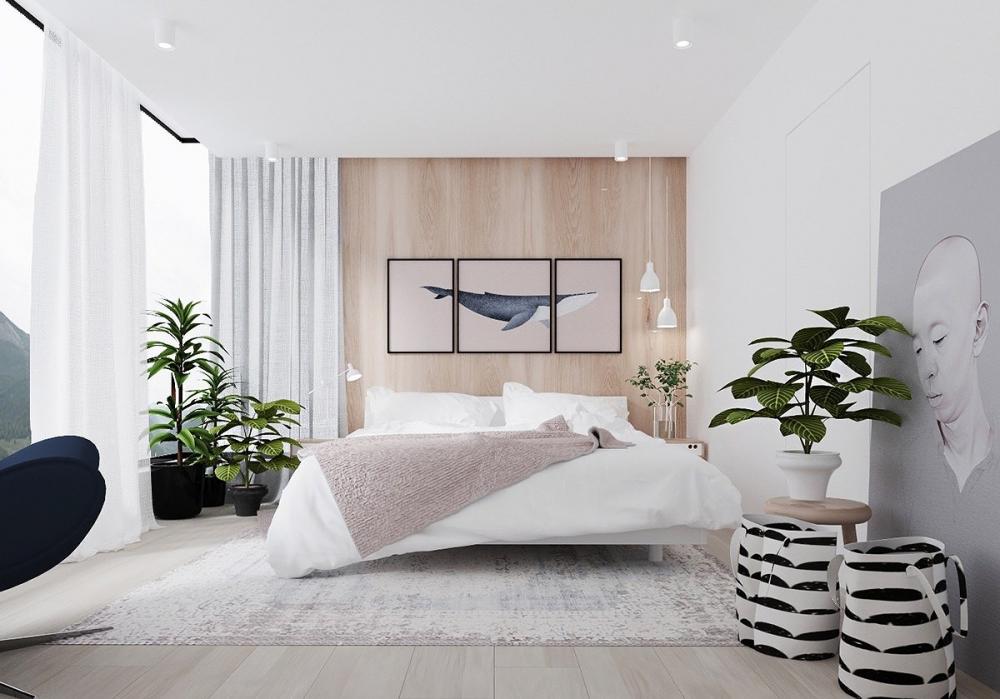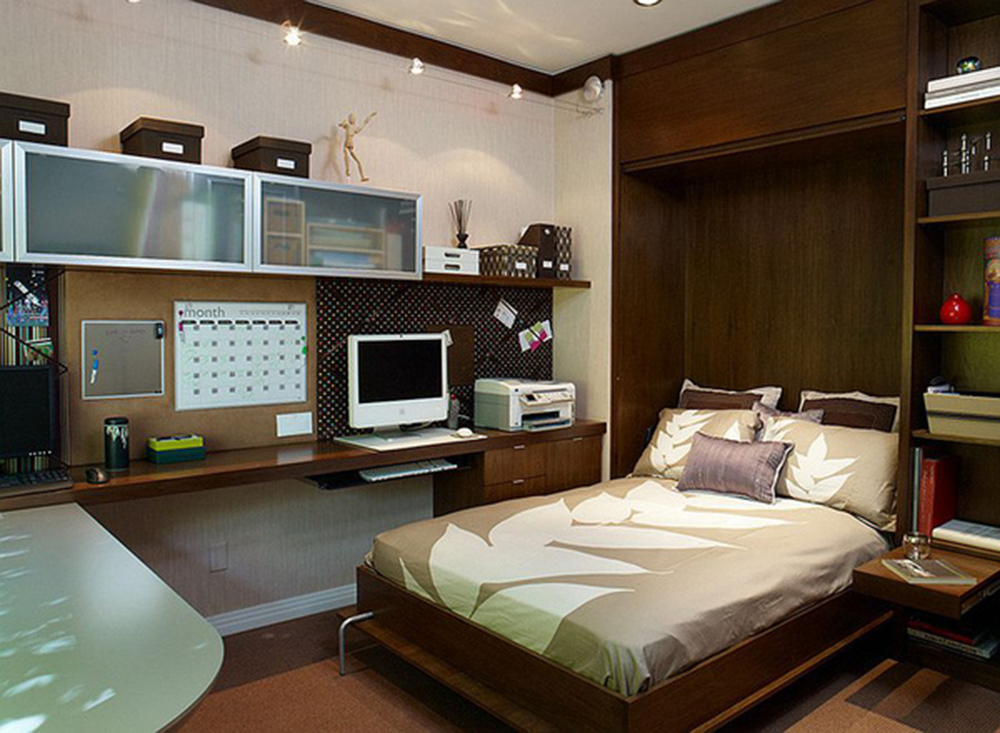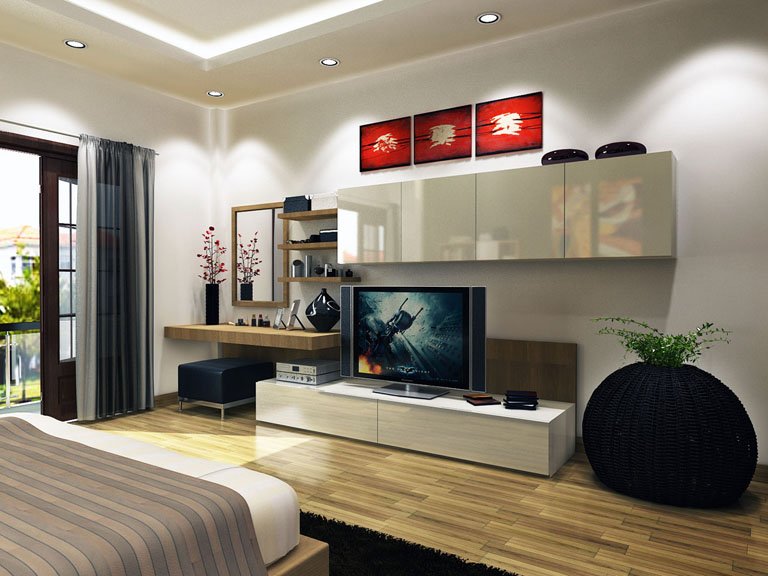The bedroom is not just a space for sleeping; it serves as a sanctuary where you rejuvenate your physical and emotional energies. If you find yourself struggling with sleepless nights or feelings of overstimulation, the ancient Chinese art of Feng Shui offers invaluable guidance on how to optimize your bedroom layout to enhances tranquility and well-being.
In this article, LotusBuddhas consults with Phung Phuong, a certified Feng Shui master in Vietnam to help you have the best overview of the problems you encounter about bedroom layout.
The Most Optimal Layout
In the pursuit of harmonious living spaces, Feng Shui has long been considered an authoritative framework, based on ancient wisdom and modern spatial psychology. To optimize your bedroom’s energy flow and enhance your health, you should arrange certain spaces to be conducive to quiet, healthy living.
- Firstly, the bed should occupy a position against a solid wall, offering the occupant a commanding view of the entryway. This alignment is instrumental in manifesting an aura of authority and control over one’s space, without positioning the foot of the bed in direct alignment with the door or windows. This mitigates potential vulnerability and disrupts the flow of “chi” or life force, ensuring a balanced environment.
- Secondly, the solid wall against which the bed rests should be free from plumbing or appliances on the opposing side. Such elements can cause overstimulation of energy flow, consequently leading to restless sleep or heightened levels of anxiety.
- The inclusion of a bedside table serves as a practical and symbolic element. Positioned beside the bed, its height should not exceed that of the mattress. An overly tall table may create an impression of oppression, subverting the room’s equilibrium.
- Moreover, it is imperative to exclude mirrors, plants, workspaces, or electronics from the bedroom layout. In Feng Shui, these items are considered to possess their unique energetic charges that may conflict with the bedroom’s primary purpose of rest, sleep well and rejuvenation. Mirrors can bounce energy around the room, disrupting sleep; plants may instigate an overly active energy flow; workspaces can manifest stress; and electronics can contribute to an agitated state of mind.
While Phung Phuong’s ideal layout serves as a robust template, it is necessary to acknowledge the individualistic nature of spatial configurations. Each person’s life situation and aesthetic preference will necessitate certain adjustments. Consequently, adaptations to the base layout may be executed to align with specific lifestyle needs without fundamentally disrupting Feng Shui principles.
Layout Adjustment for Attic Bedrooms
Crafting an optimal Feng Shui bedroom layout becomes particularly challenging when the architectural nuances of an attic space come into play. The limitations imposed by slanted ceilings necessitate a specialized approach, one that ensures energetic flow is neither stagnant nor overly stimulated. In such scenarios, the guiding principles of Feng Shui need to be adapted to ensure an environment conducive to tranquility and well-being.
Placing a bed directly under a slanted ceiling is highly discouraged, as the downward angle can exert an unsettling pressure on your crown chakra, located at the top of your head. Crown chakra is associated with spirituality, consciousness, and inspiration, and any imbalance in this energy center can lead to psychological distress. Therefore, your bed should be strategically positioned away from such angles to minimize the risk of “pushing down” on your crown chakra.
In cases where architectural limitations compel you to place the bed under a slant, it is advisable to counteract the adverse effects through thoughtful lighting. Installing sconces on either side of the bed that shine toward the ceiling can effectively negate the downward pressure exerted by the slant. These light fixtures will serve to uplift the energy within the room, creating a balanced atmosphere conducive to relaxation and restful sleep.
In addition to lighting, other elements of Feng Shui can be leveraged to harmonize the attic bedroom space. For instance, choosing colors that evoke a sense of serenity, such as pastels or earth tones, can further neutralize the challenges posed by slanted ceilings. Moreover, minimizing clutter and maintaining an open layout can contribute to an overall sense of spaciousness, thereby optimizing the flow of “chi” or life force.
Phung Phuong emphasized that Feng Shui is an adaptable art form, aimed at optimizing well-being by adjusting to the particularities of each unique space. While slanted ceilings pose a challenge to the traditional Feng Shui bedroom layout, through mindful placement and strategic design choices, you can certainly achieve a harmonious and balanced environment even within the limitations of an attic bedroom.
Layout Adjustment for a Large Bedroom
While a large bedroom might initially appear as an advantageous setting, it presents its own unique Feng Shui challenges. The temptation to fill expansive spaces with an abundance of furniture can inadvertently obstruct the flow of chi, leading to a cluttered and discordant energy landscape.
Properly managing a large bedroom space from a Feng Shui perspective thus requires a nuanced approach that strikes a balance between utilizing the area effectively and maintaining optimal energy flow.
One of the primary considerations is to resist the urge to overpopulate the room with furniture. Clutter acts as an obstacle in the free circulation of chi, and it can disrupt the equilibrium that is essential for relaxation and restorative sleep. Therefore, judicious selection and placement of furniture items are paramount.
Creating distinct zones within the bedroom can serve as an effective strategy for both functional and Feng Shui optimization. For instance, a sitting and relaxation zone can be established, anchored by a carefully chosen rug to demarcate the space. This not only enhances the aesthetic appeal but also contributes to the room’s overall energetic balance. Placing this area on the opposite side of the bed facilitates a harmonious dichotomy within the space, allowing for the unobstructed flow of energy while fulfilling multiple functions.
However, when selecting a rug or additional furniture, you should adhere to the Feng Shui principles concerning colors and materials. Natural fibers and earthy or neutral tones often resonate well with the principles of grounding and balance. Moreover, avoid placing the sitting area in direct alignment with any doors or the bed to maintain a smooth circulation of chi.
Through thoughtful zoning and careful furniture selection, it is entirely feasible to create a harmonious space that aligns with both aesthetic and energetic criteria. The end result is a large bedroom that serves multiple purposes without compromising its primary function as a place to rest, recharge and rejuvenate.
Layout Adjustment for Rooms With Several Doors
Navigating the complexities of Feng Shui in a bedroom with multiple doors presents a conundrum. Traditional Feng Shui guidelines eschew direct alignment of the bed with any door, primarily to prevent the disturbance of chi flow, thus fostering a restorative atmosphere. However, in instances where architectural constraints necessitate such an alignment, specific strategies can be employed to mitigate adverse effects on the room’s energy.
Termed dramatically as the “coffin position,” a bed aligned with a door is said to create a vulnerability in the room’s energetic balance. In this configuration, your energy may feel as though it is being pulled away, exposing you to any activity or energy in adjacent spaces. This can lead to restless sleep, heightened anxiety and general discomfort.
In a multi-door environment, choosing which door to align with is a crucial decision. Phung Phuong suggests that, if you find it absolutely necessary to align the foot of your bed with a door, the closet door would be the optimal choice. Unlike doors leading to hallways, bathrooms, or other active spaces, the closet is generally a static area devoid of activity or energetic fluctuations. Consequently, the detrimental impact on the room’s Feng Shui is minimized.
Moreover, additional Feng Shui tools can be employed to mitigate the negative effects of the door alignment. Employing screens, curtains, or other visual barriers can serve to subtly divert the flow of chi, thereby reducing its direct impact on the sleeping area. Coupled with color schemes that promote tranquility and selected Feng Shui accessories like crystals or wind chimes, these additions can contribute to restoring a sense of balance in the room.
Layout Adjustment for Rooms With Several Windows
While windows usher in natural light and facilitate a connection with the external environment, they can also disrupt the balance of energy within the room. Moreover, traditional Feng Shui principles recommend positioning the bed against a solid wall to offer energetic support and command a view of the room’s entrance.
However, if you find that your bedroom layout features windows on three out of four walls, alternative strategies must be deployed to harmonize the room’s energy.
In instances where a solid wall is not an option for bed placement, the emphasis shifts to the next best alternative. It becomes crucial to situate the bed in a position that allows for a clear sightline to the door, fulfilling the “command position” criterion. Although this might necessitate placing your bed against a window, such a compromise can be offset with specific design elements that bolster a sense of security and enclosure.
One effective way to mitigate the vulnerability posed by a windowed backdrop is by opting for a canopy bed. The canopy serves as a symbolic shield, enhancing your sense of safety while sleeping. Additionally, the fabric material can absorb some of the active yang energy entering through the window, rendering a more balanced yin-yang equilibrium within the room.
If a canopy bed is not feasible, other design interventions can also contribute to a sense of security. Installing blackout curtains or heavy drapery can serve as a temporary barrier against any disruptive energy flowing through the window. Also, employing Feng Shui-friendly window treatments, such as wood blinds or natural fiber curtains, can help moderate the chi energy entering and exiting through the windows.
As you see, while a room with an abundance of windows might seem incongruent with traditional Feng Shui guidelines, adaptable solutions exist. Through strategic bed placement and the incorporation of design elements like canopy beds or specialized window treatments, you can forge a balanced energetic environment. Thus, even within unconventional architectural layouts, Feng Shui provides flexible pathways to optimize your living space for well-being.
Layout Adjustment for Plants in the Bedroom
As shared above while plants are universally acknowledged for their air-purifying qualities and aesthetic appeal, their placement within a bedroom environment needs to be considered carefully to ensure that the Feng Shui balance is maintained.
Particularly in scenarios where the bedroom offers the optimal natural light for plant growth, or perhaps where space constraints have relegated plants to the sleeping quarters, implementing Feng Shui principles can guide you toward harmonizing this natural element within your personal sanctuary.
To start, Phung Phuong says we should avoid positioning plants in close proximity to your bed. Plants are dynamic organisms with their own energetic profiles, and their vitality can interfere with the room’s primary purpose: rest and rejuvenation. By positioning them on the opposite side of the room from your bed, you distance their energetic influence and preserve the tranquility essential for quality sleep.
Phung Phuong also suggests selecting slow-growing, downward-growing plants such as trailing succulents. These plants align with the Feng Shui principle of downward grounding energy, which can be particularly beneficial in a sleeping environment. In contrast, upward-growing plants might inadvertently infuse the room with excessive yang energy, which is not ideal for a space designated for rest.
As for optimizing sunlight exposure, placing plants in front of the window can meet their light requirements while also serving as a natural barrier that diffuses incoming sunlight, potentially harmonizing the energy within the room. However, this arrangement requires caution to ensure that the foot of your bed is not directly aligned with the window. Such an alignment would disrupt the smooth flow of chi, leading to potential vulnerabilities and imbalances in the room’s energy profile.
Layout Adjustment for Decorating With Mirrors
In Feng Shui philosophy, mirrors are potent tools that can both amplify and alter the flow of energy within a room. While traditionally not recommended for bedroom interiors due to their ability to stimulate and reflect various forms of energy, there are instances where the aesthetic or functional utility of a mirror in the bedroom becomes a consideration.
If you find yourself inclined to incorporate a mirror into your bedroom décor, certain guidelines should be observed to minimize any potential negative impact on the room’s Feng Shui equilibrium.
A basic principle to follow that Phung Phuong mentioned is the positioning of the mirror relative to the bed. A mirror that directly faces the bed can create a loop of energy that disrupts the restful atmosphere essential for quality sleep. This scenario could lead to restlessness, insomnia, or even heightened emotional volatility. Therefore, it is imperative to place the mirror in such a way that it does not reflect the bed.
Beyond mere positioning, you also have to consider what the mirror reflects within the room. Mirrors possess the ability to duplicate the energy of the objects they reflect, for better or worse. Ideally, the mirror should reflect elements that contribute to serenity and well-being, such as calming artwork. Reflecting a home office, on the other hand, could inadvertently introduce stressors and work-related energy into a space designated for relaxation and sleep, thereby compromising its Feng Shui integrity.
Additional Feng Shui tools can be employed to further harmonize the presence of a mirror in the bedroom. For instance, a strategically placed curtain could act as a barrier that moderates the mirror’s impact during sleep hours. Similarly, the frame of the mirror can be selected based on Feng Shui principles, choosing materials and colors that align with the desired energies you wish to cultivate in the room.
You can refer to: How to Hang Mirrors in Bedroom for Good Feng Shui
Layout Adjustment for a Bedroom That Doubles as a Workspace
The confluence of work and personal space in a single room poses intricate challenges from a Feng Shui perspective. While it’s typically not advisable to integrate a workspace within a bedroom, the exigencies of contemporary life often make such arrangements unavoidable.
If you find yourself grappling with this scenario, optimizing the spatial arrangement according to Feng Shui principles can significantly mitigate the potential energetic discord.
First and foremost, you have to delineate a clear boundary between the work and sleep zones within the room. The juxtaposition of a desk next to the bed is particularly inadvisable, as the dynamic, active energy (yang) associated with work can profoundly disrupt the tranquil, passive energy (yin) essential for quality sleep. Such spatial commingling could lead to restlessness, sleep disturbances, and difficulty disengaging from work activities.
If space permits, it is beneficial to position the workspace as far away from the bed as possible, ideally in a location that enables you to keep a vigilant eye on both the bed and the room’s entrance while seated at your desk. This layout respects the Feng Shui principle of the “command position,” facilitating a greater sense of control and focus while working.
When it comes to the furniture itself, selecting a desk with rounded edges can promote smoother flow of chi energy, thus fostering a more harmonious atmosphere. Opt for ergonomic chairs that provide adequate support and comfort, further aligning the workspace with wellness objectives.
To counterbalance the activating energy of electronic devices like computers or phones, consider introducing Feng Shui elements that encourage calm and balance. A small water fountain or an air-purifying plant placed on the opposite side of the room from the desk can serve to neutralize some of the workspace’s more disruptive energies.
Phung Phuong says that if you apply these principles, you can build a multi-purpose room that respects the distinct energy needs between work and rest. While not an ideal arrangement according to strict Feng Shui terms, through careful planning and thoughtful design choices, you can achieve a harmonious balance that supports both productivity and well-being.
Layout Adjustment for Those Who Esteem Their Electronics
Electronic devices inherently emit a form of active yang energy that can disrupt the tranquil yin energy conducive to restful sleep. Nevertheless, the omnipresence of electronic gadgets in modern life makes their complete exclusion from the bedroom impractical for many. In this context, implementing strategic layout adjustments can ameliorate the adverse effects of these devices on the room’s energetic equilibrium.
Firstly, it’s worth noting that minimizing the physical proximity of electronics to your sleeping area is crucial. If you rely on your phone for waking up, consider charging it outside your bedroom door. This strategy allows you to benefit from its utility as an alarm while mitigating its disruptive electromagnetic energy. Alternatively, investing in a traditional alarm clock specifically designed to promote a gentle wake-up can serve a similar purpose without any electronic interference.
For those who appreciate the leisure of watching television in bed, several solutions exist. One approach is the use of a portable projector that can be stored in another room when not in use, thus making the bedroom a temporary entertainment space rather than a permanent one. The absence of a static, physical device helps maintain a serene ambiance. Another option involves storing the television in a media cabinet with doors that can be closed when the device is not in operation. For added effectiveness, unplugging the television at night can further insulate your restful space from its active energy emissions.
Electronics like tablets, laptops, and other smart devices should also be treated with similar caution. Storing these devices in designated spots away from the bed when they are not in use will contribute to a balanced environment. Furthermore, incorporating shielding materials or grounding mats could offer added protection against electromagnetic frequencies, should you opt for such advanced measures.
Though complete elimination of electronics is the gold standard, these considered compromises offer a balanced pathway, allowing you to enjoy your devices while also nurturing a space that promotes well-being.
If you desire to create a bedroom environment where you can not only rest but also thrive, taking advantage of Feng Shui principles can bring immediate improvements as well as long-term benefits. After all, optimizing your space for good Feng Shui is not simply a matter of taste; It’s an investment in your overall quality of life. The benefits of such a harmonious space are manifold, including improved sleep quality, emotional balance and even increased prosperity.














